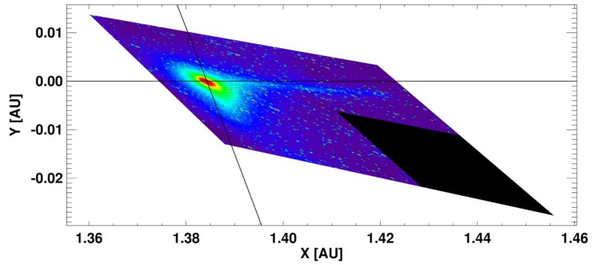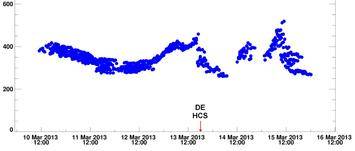Solar Windsocks is a service to derive estimates of solar wind speeds from images of comets' ion tails.
It is possible to do this because ion tails show material being carried away from comets by the solar wind - a very fast continuous stream of charged particles flowing away from the Sun. As we know where each comet is, how fast it's moving, and in what direction, we can use the position of the tail to estimate the solar wind speed at the comet.
Other features that appear in the tail, such as kinks and breaks, can reveal when the comet was crossing an abrupt boundary in the solar wind, or a reversal in the heliospheric magnetic field. Knowledge of these boundaries can help us understand how the solar wind propagates out into space, and how the Sun is behaving.
- Technique
Solar Windsocks is based on the assumption that the solar wind flow is radial, i.e. is flows directly away from the Sun. This is known to not quite be true, with the solar wind often deviating a few degrees from the radial direction, but this assumption is necessary in order to derive solar wind speed estimates from comet images.
If we know which comet is in an image, and the date and time at which the image was taken, we know where the comet's nucleus should appear in the sky. We also know the position of the comet's orbital plane in space as seen from the observer, so the image can be projected onto the orbital plane. An example of such a mapped image is shown below:

The x axis shows the distance away from the Sun, and the Y axis shows the distance in the plane of the comet's orbit, along the comet's trajectory. The solid line passing through the position of the comet's nucleus is the anti-sunward direction. In this case, the comet is moving towards +Y. The ion tail lags behind, below the antisunward vector in this view.
To derive the solar wind speed, the user clicks on several points down the ion tail, estimating the position of the centre of the tail. Each of these points is then converted into a solar wind speed, under the assumption that each marked tail section originated at the comet's orbital path and then moved radially away from the Sun. Several solar wind speed estimated can be derived from a single image.
- Example Results
The plot below shows solar wind speeds in km/s derived from images of comet C/2011 (PanSTARRS) by the STEREO-B spacecraft.

- Using the Service
Solar Windsocks is currently undergoing thorough testing, but will soon be available for any user to estimate solar wind speeds using the code. Images will need preparation before being used, as described below.
- Image Preparation
Each image to be analyzed will need to be in FITS format, with a header that provides positional information. Such files can be created by uploading any images to nova.astrometry.net . Save and rename the FITS files that are created by the astrometry.net service prior to use by Solar Windsocks.
All image files need to be carefully named so that they record the identity of the comet, as well as the date and time at which the image was taken. The format to be used is as follows:
cometID_yyyy_mm_dd_hh_mm_ss_observername_observatorycode.fits
where cometID is a simplified version of the comet's IAU code. For example, the code for comet C/2006 P1 (McNaught) in the filename would be c2006p1 (do not include the / )
Periodic comet codes are simply converted to lower case, so 45P/Churyumov-Gerasimenko would be 45p
The next part of the filename is the observing time in Universal Time, UT. Please convert any local times to UT, otherwise the positioning of the comet will be incorrrect. For long exposures, please record the time at the middle of the exposure.
yyyy is the year of observation
mm is the month
dd the day of month
hh hour
mm minutes
ss seconds (if known; can be left as 'ss' or 'xx' if not known)
observername is a phrase to identify the observer, usually just a surname or family name, but in the case of common names, initials etc. can also be added.
observatorycode is a code to identify the location of the observer using the IAU observatory code list available here . An observatory code relatively close to the actual observing site may be used for satisfactory results. If no observatory code is provided, a position at the centre of the Earth is assumed, which still provides good results in most cases. Exceptions to this are comets quite close to the Earth. The inclusion of observatorycode is optional, and can be replaced by xxx.
Note that it is an underscore (_) character between each part of the filename, not a hyphen or minus (-).
For example, an image of Comet C/1996 B2 (Hyakutake) obtained on March 23, 1996 at 03:45 UT by an observer named Smith in London, so quite close to Greenwich Observatory (observatory code 000) would be:
c1996b2_1996_03_23_03_45_xx_smith_000.fits
An image of comet 8P/Tuttle at the same time from Vilnius (observatory code 070) would be:
8p_1996_03_23_03_45_xx_smith_070.fits
The use of this filename format allows key information about each comet image to be recorded automatically.
Donation of Images to the Project
When images are uploaded, users will be asked whether they are happy for images to be stored and used for further analysis by other users, as part of the Solar Windsocks database. Each image will be of great scientific value to help determine the behaviour of the solar wind throughout the inner solar system, complementing solar wind speed measurements made by spacecraft. The contribution of each observer will be acknowledged and appreciated.
Acknowledgements
The Solar Windsocks project is only possible through the financial support of the Europlanet-2020 Research Infrastructure, funded by the European Commission. Solar Windsocks is part of the Europlanet Planetary and Space Weather Services activity. The Solar Windsocks code is based on an original code created by Dr Yudish Ramanjooloo, now at the University of Hawaii, USA.
 Close
Close

